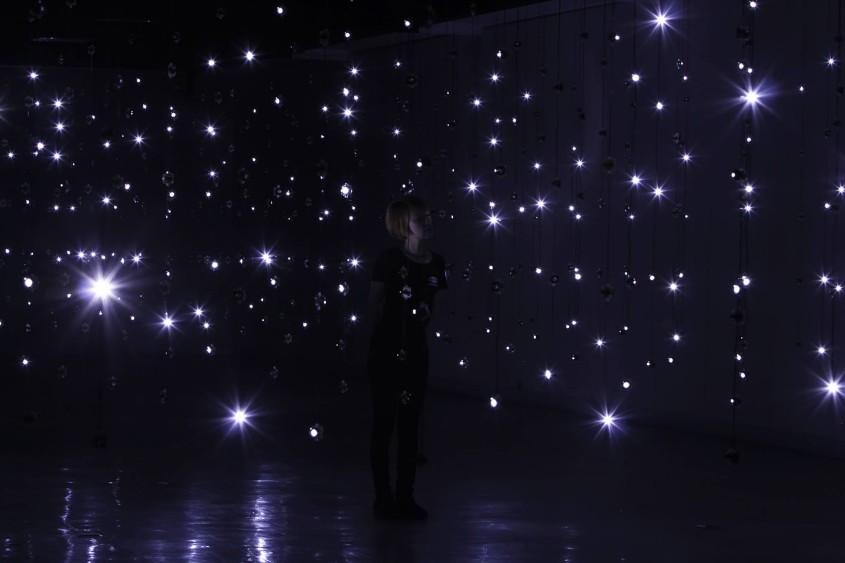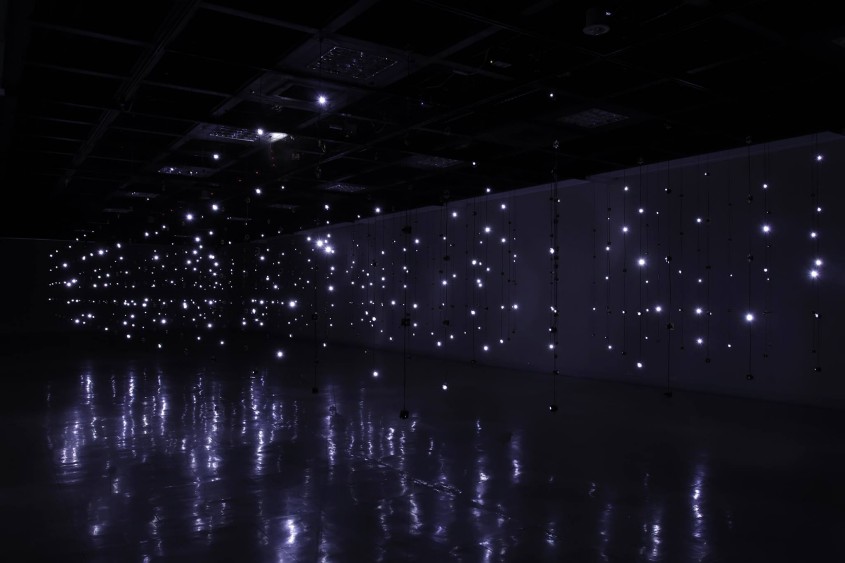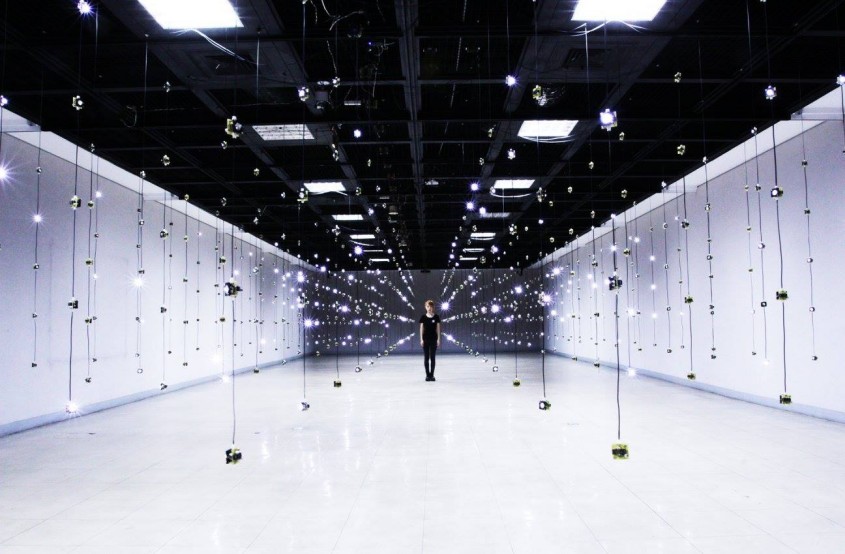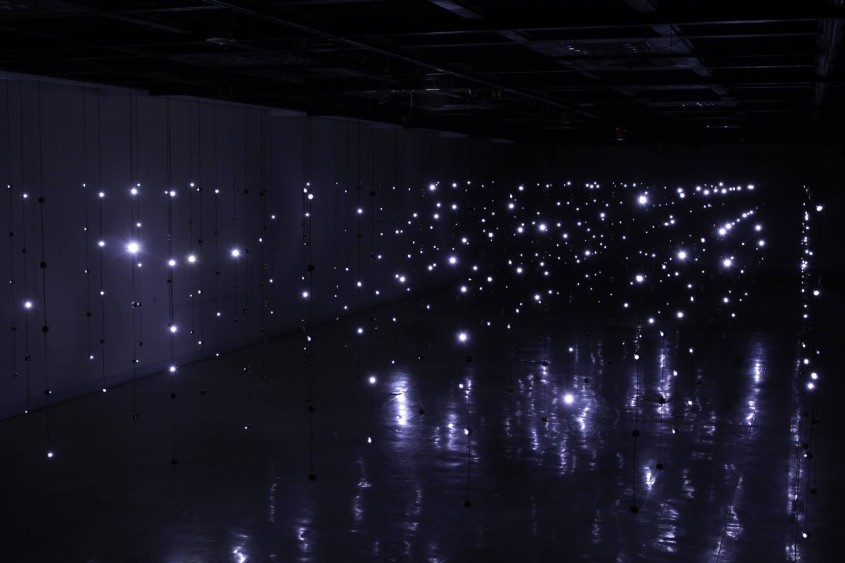►聲音藝術-Moving Sound Forest Exhibition 移動的聲林展
攝影+文:盧藝
Photo and Essay by Yi Lu
9/19-10/19.2015
https://www.facebook.com/events/120202864992978/

One of Fujui Wang’s major exhibitions in 2015 is “Moving Sound Forest Exhibition” which was opened at New Taipei City Art Center. The idea is extended from that of “Sound Forest under the Cloud” exhibition in Digital Art Center/DAC in Taipei in 2010 where only 250 Sound Dots were included. Yet after checking the size of the space at New Taipei City Art Center, Fujui, my teacher, and I had the idea of increasing the number of dots into 1000 and trying to let the sound dots with respective sound characters collide and traverse in the space, creating energy of many levels.
Sound Dots have undergone many different ways of move in diverse spaces. In different venues, they all smoothly bring about different sounds. Combined with different kinds of spaces, different numbers of Sound Dots create experiences of different realities.
How to describe Fujui Wang’s work? In a performance titled “Tasks” curated by the artist duo, Jasmin and Bilwa, in an abandoned beer factory in Berlin, nine dancers held tiny devices that produced physical sounds in their hands. Their movements in the immense space produced sounds that started from the dancers’ hands and hit the walls. The echoes went back and forth, superposing one another to make a 3-dimensional feeling of flow. Rather, we can describe the work with the following metaphor: when we’re in my teacher’s sound forest, we felt the sounds automatically keep on superposing, intersecting, alternating, vibrating, becoming organic, near and far…at the instants when our ears chased after them to identify them. By spreading so many Sound Dots in the basement of the factory, Fujui created a situation where one promenades with one’s consciousness in a deep forest alone. Fujui said he has been seeking all the possibilities of sound. Perhaps for this reason, his work unconsciously represents a flavor that corresponds to nature.
I wonder whether if everyone discerned the circumstantial sounds made with Sound Dots arranged by Fujui during the opening performance. There was a section of a similar sound of raindrops. The sound of water makes us calm and bears the imagery of nature. As for Sound Dots, although there were technological sounds created in the collisions of electronic chips as well as LED lights produced under the crashes, they were transformed into natural insects’ cry and the starlight. The entire opening performance made one feel like being overwhelmed by the ocean.
Maybe in one’s life, beautiful and comfortable sounds should be like those of waves and of amniotic fluid inside the womb, immense and steady, calm and slow, rich and extending. Just like the flow in the powerful crevices between life and death. Certainly, the tension of sound felt in one’s real experience cannot be described with any language or words. It cannot be depicted in others’ minds either. Fujui’s exhibition will be shown until October 19. One can define how he/she feels about such sound.
王福瑞老師2015年度大展:『移動的聲林』已於新北市藝文中心盛大開幕了,發想是2010年在數位藝術中心展出『雲端下的聲林』想法作為延伸,當時展出只有250顆『聲點』的規模,但在看過新北市藝文中心地下展場空間大小後,我和老師有個想法:把聲點擴大到一千顆,試試讓每一顆不同聲音狀態的『聲點』,在空間中穿梭撞擊出層次的能量。
『聲點』已經經歷了許多不同空間狀態的前進,從白木耳雜誌邀請的紐西蘭巡迴表演的基督城The Physics Room Gallery、國際策展人王俊琪策劃的城市閃爍IV展的柏林The Leap空間、聲音藝術家姚大鈞策劃的中國聲音藝術大展在上海油罐區,以及最近盧森堡Casino美術館與立方空間鄭慧華共同策劃的“文明魅影”聯展…等,『聲點』在不同形式的藝術空間均流暢出不同的聲音,不同顆數的『聲點』與不同型態的空間相乘出不同真實感的體驗。
要怎麼描述老師的作品呢?最近在柏林的一處廢棄啤酒工廠的一場聲音表演:『tasks』*(由兩位藝術家Jasmin and Bilwa組成團體為主策劃),『tasks』由9位舞者以手持一些會發出物理聲音的小裝置,在巨大的空間裡移動所產生的位移聲響,聲音從舞者手出發出撞擊到牆壁的回應,來回重疊交替成一種立體的流動感,而更,可以用這個比喻來形容,當我們處在老師的聲林中,聲音就自動在我們耳朵追著分辨的當下,不停地重疊、有機、交替、律動、遠近…。老師把這麼多顆的聲點佈滿在這個地下室的空間,創造出一抹獨自深林中與思緒意識漫步的情境,老師說他一直在追求聲音的所有可能性,作品中無意識呈現一股呼應自然的調味,或許。*http://collaboration.jasminschaitl.com/
開幕表演不知道大家有沒有聽出來中間有一段是雨聲,是雨水的聲音,水聲使人寧靜,而『聲點』雖然電子晶片震盪出來的科技聲響,光為震盪時的LED亮光,卻也被老師轉化成自然的蟲鳴、自然的星光。老師的表演就像大海的聲音,是認知中屬於生命力的讚美,或許生命中,美好舒服的聲音就應該像海浪聲般,子宮中的羊水聲,心跳頻率的流動,巨大且穩定、豐富且延伸。就像介於生與死之間有力度的的空隙,流動。
當然所有語言文字不能描述親身經歷的聲音張力,也無法在別人的心中刻化出來,這個展就到10/19號止,自己的聲音感受就由自己定義。
Photos:Courtesy of Soundwatch Studio

福瑞:『原先Sound dots設計是只有純聲音的想法,考量到作品本身有光,讓觀看比較有視覺依循,如果整個展場全暗,觀眾不知道要怎麼欣賞作品,剛好在網路上看到工廠喇叭清庫存,當時用便宜價格購入約2000顆庫存小喇叭,再加上白光LED,讓Sound dots同時可以擁有聲音與光,聲音與光均來自同一組電流訊號。』整體設計上王福瑞將LED反轉朝向該小喇叭的震膜上,造成一種反射的光視覺層次。王福瑞有提到早期在”在地實驗”創作時,體積大的作品很難搬運(例如”黃色潛水挺”那件作品),後來開始自己獨立創作後,漸漸地思考作品運輸的方便性。『如果作品可以拆解再組裝,運輸的可能性就可以提高,所以Sound dots是採模組化方式,每一顆的點可獨立收納在方格式的盒子,到展覽現場再以人工串接的方式一個個組裝起來。』
關於極簡:
很多人會覺得王福瑞的作品帶有極簡風格,王福瑞提到:除了希望把視覺的比重減少外,也希望觀者在欣賞作品不要一直被視覺拉走,畢竟聲音是很抽象的,如果作品外型結構太搶眼,會失去我原先設計作品想傳達的意義。
怎麼看待音樂與聲音?
我是從聆聽大量音樂開始,漸漸地喜歡上運用聲音和本身的程式背景來進行實驗與創作,除了挑戰聲音的可能性外,音樂對我而言有固定的樂理以及規則是我一直想超越與打破的,如果我可以引起大家對聲音認知感到興趣或有對聲音新的體悟,就是我創作的核心。
媒體:
►王福瑞《移動的聲林》:聲林再造計畫
http://solomo.xinmedia.com/photo/24825-movingsoundforest/1
►藝術很有事第22集之1 :【來自初始與未來的聲音】
在藝術的類別中,聲音藝術不像視覺藝術那麼受到矚目,也不那麼容易被理解,就如同在生活當中,聲音比視覺抽象,又容易被忽略。
►藝術很有事第22集之3 :【聲音藝術在台灣】
榮恩和馬克兩兄弟來自紐西蘭,在台灣創辦了《白木耳》藝術雜誌,長期關注台灣藝術的發展,尤其是聲音藝術。馬克說,大家常問他「台灣看起來怎麼樣」,而不是「台灣聽起來怎麼樣」,但在他們的聽覺經驗中,台灣充滿各種西方難遇到的聲音,很令人驚奇。他們怎麼解讀聲音,並看待台灣的聲音藝術呢?



